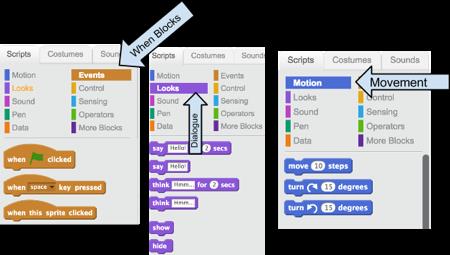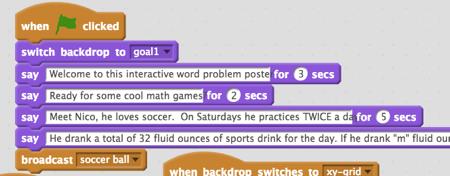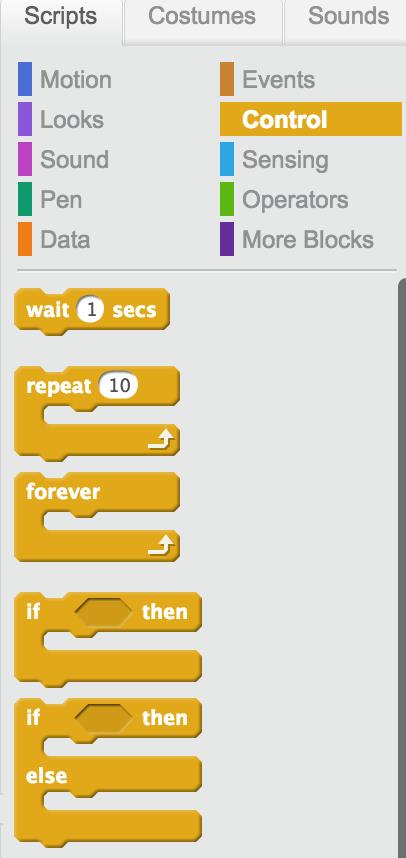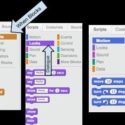MaKey Makey and Scratch Lesson Plan: Interactive Word Problem Posters for Levels 4-12.
This lesson plan was published by MaKey Makey, and it is the intellectual property of Teacher Librarian Colleen Graves, who has written countless articles and lesson plans on the subjects of STEM and challenge-based learning.
Appropriate for grade levels 4th to HS
Kids always struggle with word problems. Why not have them create their own word problems as an interactive poster? With Makey Makey you can help your kinesthetic learners write, answer, and share their own word problems in Scratch.
Lesson Objectives
- Write word problems appropriate for their grade level (or younger)
- Understand the functions of mathematical operators
- Create a logical sequence in Scratch to be played in the real world
- Utilize MaKey MaKey to have students physically interact with multiple choice questions
Lesson Materials
- MaKey MaKey for each student or partner groups
- Alligator Clips
- Manilla Paper/Poster Paper
- Copper Tape, thumbtacks, or pencils
- Scratch game to remix
Writing Word Problems
DAY 1
Teach students how to write their own word problems.
- When students work a word problem, they often have to determine what equation they need to use to solve that problem. Therefore when writing a word problem,students should start by determining the equation that their word problem will be about.
- Students will need to brainstorm, who is doing what and why? What type of activities would students like to write about? Soccer practice? Going for pizza? Going shopping? Apps on a phone? What type of numbers are involved? What kind of situation could use the equation they want to use? Generally there is a total number given and students must decide an equation for solving the problem, and find the missing info/number based on that equation.
- Students need to read and revise word problems for fluency before making a Scratch game and interactive poster.
- Students must create wrong answers to accompany their word problem. They should consider what equations might trick students when playing their game.
- Here is an interesting lesson on connecting English language arts and math through writing word problems on readwritethink.org for younger grades.
|
Example Word Problem: On Saturday, Nico practices soccer twice. He drank a total of 32 fluid ounces of sports drink for the day. If he drank m fluid ounces at morning practice, which equation can be used to find n, the number of fluid ounces for the rest of the day?
If the variable m = 15 what is n? |
https://scratch.mit.edu/projects/70430226/
DAY 2
Students will learn to program keys for a Sprite (character in game) and create dialogue for the Sprite to make their word problem poster interactive.
Have students remix this Scratch game with their word problems or start their own in Scratch.
Here is a basic tutorial from my ELA Logic Puzzle Lesson:
- Sign into Scratch.
- Familiarize students with the Scratch work area.

- Familiarize student with the Scripts (Blocks) for today’s lesson.

- Pick a Sprite and a backdrop to get started.

- When Block- All games need to start somewhere, and the first thing you need to do is program your game to start by dragging a “When (Green Flag) Block” to your “Scripts” area for your main Sprite.

- Looks Block- Next you need to program your Sprite to speak. Click on the purple “Looks” in the Scripts area to find a “say Hello! block.” Change “hello” to the word problem. You may have to use a few “hello” blocks to have enough room to write your question. Drag the purple block to your “When (Flag) clicked” until it clicks together. You can click on your script to run it and see how it functions.


- Coding Logic – Small bits of code that can create complex games. For a great explanation and writing lesson about If/Then Statements look here.

Hooking up MaKey MaKey to Poster
DAY 3
Make your word problem poster interactive by attaching Makey Makey to pencil drawings or copper tape.
Decide your conductor: Have students decide if they want to use copper tape, thumbtacks, or pencil drawings to create their posters.
Draw and Write: Students need to write the equations for their game. In her game, Colleen Graves had the operators as the switch for students to know if they are correct. So each operator is the “key” attached to the MaKey MaKey.
Connecting to earth: Students should make an aluminum foil bracelet for others to wear when playing their game.
Connecting keys: Hook the operators/equations/numbers on the poster to the appropriate keys on the MaKey MaKey.
Play and answer: Have students gallery walk the room and answer each other’s word problems. Colleen suggests carrying pencil and paper or iPad to record answers for each station.
Evaluate: At the end of the day, have students discuss which word problems they like best and why. Ask students to reflect on the hardest/easiest parts of crafting their own word problems.
Resources:
Ford, Beverly. “Writing a Multiplication Word Problem.” Writing a Multiplication Word Problem. AIMS Education Foundation. Web.
“Solving the Math Curse: Reading and Writing Math Word Problems.” – ReadWriteThink.org IRA/NCTE. Web.
Standards
Note on Standards
These lessons were developed with the idea that teachers all over the globe and a variety of grade levels could hack the lesson plan to meet their students’ needs. Therefore, these are just some of the standards the lessons are based on, and not an all-inclusive list. Many of the CCSS align by grade level, so if you teach 9th grade, you could find the stair-stepped standard for CCSS.ELA-LITERACY.W.8.6 by looking at CCSS.ELA-LITERACY.W.9-10.6.
Common Core
CCSS.MATH.CONTENT.6.G.A1-4: Solve real-world and mathematical problems involving area, surface area, and volume.
CCSS.MATH.CONTENT.4.OA.A.1-3: Use the four operations with whole numbers to solve problems.
CCSS.MATH.CONTENT.4.G.A.1-3: Draw and identify lines and angles, and classify shapes by properties of their lines and angles. (Depends on the type of word problem you have the student write.
CCSS.MATH.CONTENT.8.G.A.1: Understand congruence and similarity using physical models, transparencies, or geometry software.
CCSS.MATH.CONTENT.8.G.C.9: Know the formulas for the volumes of cones, cylinders, and spheres and use them to solve real-world and mathematical problems.
CCSS.MATH.CONTENT.8.EE.A.1-4: Expressions and Equations Work with radicals and integer exponents.
CCSS.MATH.CONTENT.8.EE.C.7: Analyze and solve linear equations and pairs of simultaneous linear equations/ Solve linear equations in one variable.
CCSS.MATH.CONTENT.8.EE.C.8.C: Solve real-world and mathematical problems leading to two linear equations in two variables.
NGSS
4-PS3-2: Make observations to provide evidence that energy can be transferred from place to place by sound, light, heat, and electric currents.
4-PS3-4: Apply scientific ideas to design, test, and refine a device that converts energy from one form to another.*
MS-PS4-1:Use mathematical representations to describe a simple model for waves that includes how the amplitude of a wave is related to the energy in a wave. Use mathematical and/or computational representations of phenomena or design solutions to support explanations.
* The performance expectations marked with an asterisk integrate traditional science content with engineering through a Practice or Disciplinary Core Idea.
Cross Cutting Concepts in NGSS
- Patterns. Observed patterns of forms and events guide organization and classification, and they prompt questions about relationships and the factors that influence them.
- Cause and effect: Mechanism and explanation. Events have causes, sometimes simple, sometimes multifaceted. A major activity of science is investigating and explaining causal relationships and the mechanisms by which they are mediated. Such mechanisms can then be tested across given contexts and used to predict and explain events in new contexts.
- Scale, proportion, and quantity. In considering phenomena, it is critical to recognize what is relevant at different measures of size, time, and energy and to recognize how changes in scale, proportion, or quantity affect a system’s structure or performance.
Plaz Tech Educational in Atlanta, GA offers a series of workshops designed specifically for educators who are looking for fun and innovative ways to engage students through hands-on comprehension strategies and applications.
Plaz Tech’s MaKey MaKey and Scratch Workshop, is a day-long course, which teaches how to incorporate circuits and programming into almost any lesson, as well as experiment by creating an instrument, remixing a video game, and making interactive poster. The workshop includes a MaKey MaKey Kit with everything you need for the projects. Additional MaKey MaKeys are also available for purchase.
Questions? Please contact Martin Plazyk at 770.284.0709, or by email at martin.plazyk@gmail.com.


Sorry, comments are closed for this post.